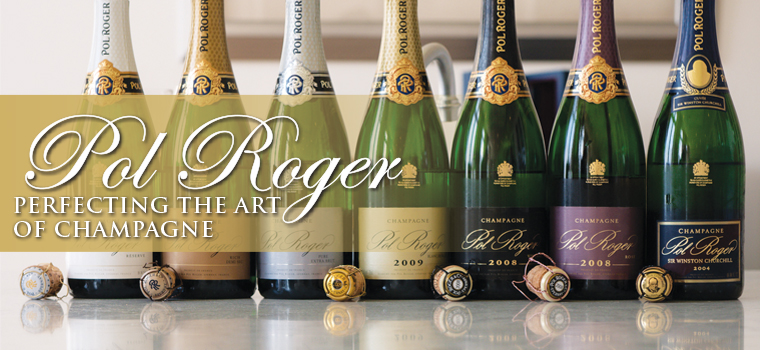PERFECTING THE ART OF CHAMPAGNE
“There has been evolution, too, in Pol Roger’s winemaking regime: “Not a revolution,” says company president Laurent d’Harcourt, “but with different-sized tanks, temperature control and cold settling, where it used to be more grape by grape, cru by cru, now the fermentation process is terroir by terroir.”
NIGEL HOPKINS
POL Roger might have an international reputation as a “British” champagne, not least because of its “By Appointment” to the British royal family, served at numerous royal weddings, and that it was much loved by Sir Winston Churchill, but it could also as much be considered an “Australian” champagne.
True, we never had an ambassador for Pol Roger to match Churchill, who is said to have drunk some 42,000 bottles in his life. Hardly surprising that Pol Roger’s finest vintage cuvée is named after the politician and that its cellar door street address was renamed 1 Rue de Winston Churchill in his honour.
But Australia did have the legendary Bob McLean, who began his career in the wine industry in the 1970s working with Orlando, who distributed Pol Roger in Australia. McLean would become Orlando’s national PR manager and one of Pol Roger’s finest ambassadors.
As the noted UK wine writer Jancis Robinson wrote after McLean died in 2015: “He took to PR like a duck to water at Orlando, where he eventually became responsible for promoting Pol Roger in the Australian market, taking it from number 12 to number three in the Australian wine industry. Bob was rumoured to have a tasting allocation of a pallet per annum.”
And while Churchill was happy to say, “My tastes are simple, I am easily satisfied with the best,” McLean’s motto was: “Never give away a bottle with the cork in it.” Those who attended his memorable lunches wondered if he hadn’t managed to give away Pol Roger’s entire profits.
The other person who cemented Pol Roger’s foothold in the Australian market was fourth generation Christian Pol Roger, who made frequent visits to Australia as a roving ambassador for the house, the last in 2008. While there was nothing new about visiting Champenoise, Christian built a large and loyal following both in the trade and among loyal customers and was a huge success for the Pol Roger brand.
There’s another happy coincidence. Pol Roger is imported into Australia by Samuel Smith & Son, owned by Yalumba. Both Yalumba and Pol Roger were founded in 1849 and both remain family owned, each now entering their sixth generation.
Pol Roger was originally founded in the town of Aÿ by the then 18-year-old Pol Roger under the single name of Roger. In 1851, the company moved to Épernay where it still resides. At first it did not own vineyards and produced exclusively for other large houses such as Perrier Jouët or Moët & Chandon, but by 1855 Pol Roger had acquired his own vineyards and decided to produce sparkling wine under his own label, focussing on brut champagne since this was the kind the British preferred.
While Pol Roger remains one of the largest family-owned houses in Champagne, it is one of the smaller of the grand marques, about half the size of Bollinger, for example, with total production of around 1.5 million bottles or 125,000 cases – of which about a tenth is allocated to Australia, placing us as its sixth biggest market.
Of this, just over 90 per cent is the non-vintage white foil Brut Reserve, made from equal parts of pinot noir, chardonnay and pinot meunier. While Pol Roger makes a higher proportion of vintage champagne than most houses, the volumes are still relatively very small with less than 1500 cases annually allocated to Australia.
These include the Brut Vintage (60 per cent pinot noir, 40 per cent chardonnay) produced only in exceptional years and a Blanc de Blanc (100 per cent chardonnay from a single year) – the 2013 vintages of each awarded five stars by Winestate judges, as was the zero dosage and very dry Pol Roger Pure Extra Brut NV. There is also a Vintage Rosé (50 per cent pinot noir, 34 per cent chardonnay and 16 per cent vin rouge) – and, of course, the Cuvée Sir Winston Churchill: there is an agreement between Pol Roger and the Churchill family not to disclose the varietals.
It is, however, produced on the lowest and coolest level of the 7km long cellars of Pol Roger, sitting at a consistent 9C, along with a stock of some two million bottles of Pol Roger maturing for up to four years for the non-vintage and seven years for vintage wines. Unusually for one of the grand houses, Pol Roger continues to riddle by hand, taking three weeks longer to complete the process than producers using the gyropallette.
Today, Pol-Roger owns about 100ha of vineyards in the Vallée d’Épernay as well as the Côte des Blancs, which are all family managed and provide about half of the required grapes, with the rest coming from up to 150 growers.
There has been evolution, too, in Pol Roger’s winemaking regime: “Not a revolution,” says company president Laurent d’Harcourt, “but with different-sized tanks, temperature control and cold settling, where it used to be more grape by grape, cru by cru, now the fermentation process is terroir by terroir.”
Renovations to the cellars and the building of a new production hall has given the company’s winemakers the capacity to vinify many more lots separately and, d’Harcourt adds, “to give us more precise possibilities for the blending” – the all-important art of champagne.

